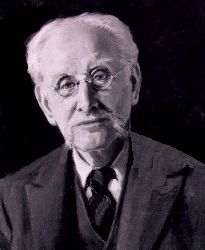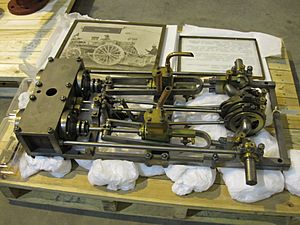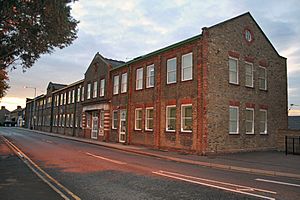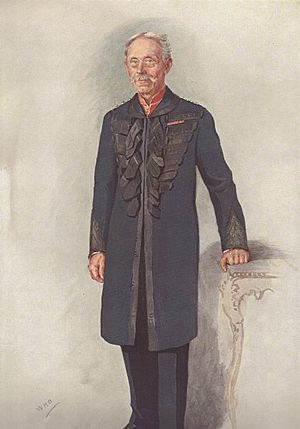R. E. B. Crompton facts for kids
Quick facts for kids
R. E. B. Crompton
|
|
|---|---|

Colonel R. E. B. Crompton
|
|
| Born |
Rookes Evelyn Bell Crompton
31 May 1845 |
| Died | 15 February 1940 (aged 94) North Yorkshire, England, UK
|
| Occupation | electrical engineer industrialist inventor |
| Awards | Faraday Medal (1926) |
Rookes Evelyn Bell Crompton (born May 31, 1845 – died February 15, 1940) was a British electrical engineer, a business leader, and an inventor. He was a pioneer in bringing electric lighting and public electricity to homes and cities.
His company, Crompton & Co., was one of the first big companies to make electrical equipment. He also worked to create an international standard for electrical systems. He helped start the International Electrotechnical Commission and was president of the Institution of Electrical Engineers twice. He was also a member of the Royal Society and helped start the Royal Automobile Club.
Contents
Early Life and Education
Evelyn Crompton was born in Sion Hill, near Thirsk, Yorkshire. He was one of five children. From a young age, he loved machines and engineering. He once said that visiting the Great Exhibition when he was six years old deeply impressed him. He especially loved the "Machinery Hall" with its shiny locomotives.
He went to school at Sharow, then Elstree, and later Harrow. His education was stopped when the Crimean War began in 1854. Even though he was young, he wanted to join the army. After the war ended in 1856, he traveled to Crimea. He visited his brother who had been on the front line. For this, he received the British Crimean War Medal.
After Crimea, Crompton went back to Harrow School. He wasn't keen on the usual lessons, so he studied extra mathematics. He even built his own machine to make static electricity. He also did experiments with Leyden Jars, which store electric charge. During a summer break, he designed and built a steam tractor that could drive on roads. He called it Bluebell.
After Harrow, Crompton got a job at the Doncaster Works of the Great Northern Railway. Here, he learned a lot about engineering. But he still liked military life. In 1864, he joined the British Army and served in India with the Rifle Brigade. In India, he saw the Royal Engineers building narrow gauge railways. This made him very interested in steam engines for transport. He had his Bluebell shipped to him from Britain. He convinced his commanders to use steam engines and lorries to move goods instead of bullock-drawn carts. He even designed some of the military steam wagons himself.
Crompton & Co. and Electric Lighting
Crompton returned from India in 1875. He decided to follow his passion for engineering. He became a partner and manager at T.H.P. Dennis & Co., a company that built farm mills and heating systems in Chelmsford. He designed a new metal foundry for his brother's business. To make the mill work day and night, it needed very good lighting. Crompton designed and put in an arc lamp system. He even improved the dynamo (a type of electric generator) that Emil Bürgin had built in Switzerland.
Crompton believed that electric lighting was the future. He saw problems with the French arc lamps being used then. So, he created his own design. His lamps gave a much brighter and steadier light. He was so confident in his design that he bought out T.H.P. Dennis. In 1878, Crompton & Co. was formed. This company made, sold, and installed Crompton's lamps.
His reputation grew quickly. When Joseph Swan was developing his incandescent light bulb, he asked Crompton for advice. Soon, Crompton was making Swan's light bulbs under a special agreement. His company became the main supplier of lighting in Britain.
By 1881, Crompton & Co. made complete electrical systems. Crompton designed and built dynamos, switchgear, circuit breakers, motors, and electric meters, as well as lamps. He showed off his lamps at big public events like the Henley Regatta and Alexandra Palace. He installed lights at Windsor Castle and King's Cross station. He also lit up many country houses, factories, tram networks, railway yards, and docks. Outside Britain, he lit the Vienna State Opera, which was the first theater in the world to be lit by electricity.
In 1887, Crompton designed and installed one of the world's first public electricity supplies. It used a central power station in Kensington Gardens in London. Seven steam engines connected to Crompton dynamos supplied power from an underground space. This system was very successful. It led to many orders for similar systems around the world. Crompton supplied equipment across the British Empire. Power stations were built as far away as Australia, which got its first Crompton lighting plant in 1887. In 1899, his company installed a generator in a Calcutta hotel. This was India's first electricity supply. India became a big market for Crompton & Co. He even opened offices there.
Crompton was very involved in his business. In 1895, a fire broke out at a power station in London that his company had installed. It was near his home. He rushed to help workers try to stop the fire. He wanted to prevent it from reaching some fuel oil tanks. As the fire spread, he went home and helped carry firehoses through his house and out the back windows. These windows faced the power station. He kept fighting the fire, even though he got several electric shocks and small burns from a flooded battery bank.
Today, at the site of the old Crompton Parkinson Works in Chelmsford, the Crompton Building still stands. It is now used as a health clinic and homes. The roads in the nearby housing area are named Rookes Crescent, Evelyn Place, and Crompton Street. There are also stone plaques in the buildings that remember Crompton's achievements.
Military Service and the Boer War
When the Electrical Engineers, Royal Engineers (Volunteers) was formed in 1897, Crompton became its leader. He was given the rank of major. He designed many searchlights for military use. These ranged from small ones on tripods to large fixed ones using his own arc lamp design.
Early in the Second Boer War, Colonel Robert Baden-Powell used searchlights to stop night attacks during the Siege of Mafeking. Soon after, Crompton led a group of Electrical Engineers Volunteers to South Africa. They used electric searchlights. This was the first time the Royal Engineers used such equipment in a war. The group served from April to October 1900 in the Transvaal and Orange Free State. Crompton was promoted to lieutenant-colonel. He was praised for his efforts and later given the honorary rank of colonel. He continued to lead the London Division of the Electrical Engineers Volunteers until he retired in 1910.
Standardisation of Electricity
After the war, Crompton became worried about all the different standards used by electrical companies. Many companies started in the 1890s. Each chose its own settings for voltage, frequency, current, and even the symbols on circuit diagrams. Buildings next to each other could have completely different electrical systems. This was because different companies had installed them. Crompton saw that this was not efficient. He began to suggest an international standard for electrical engineering.
In 1904, Crompton represented Britain at an exhibition in Saint Louis. He gave a speech about standardisation. It was so well received that he was asked to help create a group to manage this process. He said it would be "great difficulty" but he started the work.
By 1906, his work was finished. He wrote the rules for the International Electrotechnical Commission (IEC). This group had its first meeting that year in London. Representatives from 14 countries attended.
The IEC's work was stopped by the Great War (World War I). During this war, Crompton was asked to design a "Land Ship." This vehicle could cross enemy trenches and barbed wire. It also had to protect its occupants from bullets. His design became the basis for the first practical tanks.
The IEC met again in 1919 in Geneva. Germany was not officially invited, but an unofficial group came. Crompton insisted on greeting them, even though other members were uneasy. He said he felt "great satisfaction that our peacemaking efforts were successful."
In 1926, Crompton received the Faraday Medal for his work. Two years later, work began on Britain's National Grid, a country-wide electricity network.
Later Life
Crompton & Co. was one of Britain's biggest electrical equipment makers. But in the 1920s, huge global companies like General Electric and Siemens started to grow. Crompton's company began to lose ground. In 1929, Crompton & Co. merged with a rival company, F & A. Parkinson Ltd. They formed Crompton-Parkinson. This merger surprised many in the industry.
After the merger, Crompton retired. He left the company to Frank Parkinson. In 1939, he moved from his London home to a house in his home county of Yorkshire. The house had no electricity. But his former company installed a power generator for him for free.
Colonel Crompton died in February 1940, at the age of 94.
Other Interests
Besides his work in engineering and electricity, Crompton loved cycling. He bought his first bicycle in the 1890s. Of course, he changed and improved it. He changed the wheel size and pedal cranks. He claimed he could cycle 200 miles (320 km) without getting tired.
As someone who loved all things mechanical, he was also one of the first people to own a car. He helped start the Royal Automobile Club. He was also president of the Institute of Automotive Engineers.
Starting from his time at Harrow, he was a keen squash player. His dedication to standardisation even included this sport. He did experiments to compare how much different squash balls bounced.
Crompton's Companies Today
Crompton-Parkinson later became part of the Hawker Siddeley Group in 1968. That group was broken up in the 1980s. Today, several companies still use the Crompton name. They are all connected to Crompton & Co. through many mergers and changes:
- Crompton Lighting: This is one of the oldest lighting makers. It is still based in Britain, with factories in Doncaster, Yorkshire. Its main offices are in Waltham Abbey, Essex. The company is now part of the American company Cooper Industries. The Crompton name is still used on many products. A separate company with the same name operates in Australia. It came from Crompton & Co.'s Australian branch.
- Brook Crompton: This company makes electric motors. It has facilities in 5 countries and is based in Huddersfield, Yorkshire. It is owned by a company from Singapore.
- Crompton Controls: Based in Wakefield, Yorkshire, this company is privately owned. It makes switchgear, relays, solenoids, and other electrical parts.
- Crompton Instruments: This company makes mechanical and electronic electrical meters and related measuring tools. It has been part of Tyco International since 2002.
- CG Power and Industrial Solutions: This is the modern company that came from Crompton & Co.'s operations in India. It is based in Mumbai. Like the original company, it makes many products, including switchgear, motors, generators, transformers, and meters. The company is also helping to bring electricity to Indian Railways.
- Crompton Greaves Consumer Electricals




